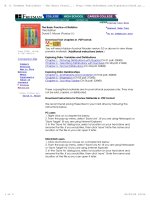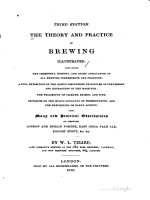- Trang chủ >>
- Y - Dược >>
- Ngoại khoa
oxford handook of rheumatology 3rd ed
Bạn đang xem bản rút gọn của tài liệu. Xem và tải ngay bản đầy đủ của tài liệu tại đây (3.14 MB, 674 trang )
OXFORD MEDICAL PUBLICATIONS
Oxford Handbook of
Rheumatology
00 Hakim FM.indd i 6/6/2011 4:56:27 PM
Published and forthcoming Oxford Handbooks
Oxford Handbook for the Foundation Programme 3e
Oxford Handbook of Acute Medicine 3e
Oxford Handbook of Anaesthesia 2e
Oxford Handbook of Applied Dental Sciences
Oxford Handbook of Cardiology
Oxford Handbook of Clinical and Laboratory Investigation 3e
Oxford Handbook of Clinical Dentistry 4e
Oxford Handbook of Clinical Diagnosis 2e
Oxford Handbook of Clinical Examination and Practical Skills
Oxford Handbook of Clinical Haematology 3e
Oxford Handbook of Clinical Immunology and Allergy 2e
Oxford Handbook of Clinical Medicine—Mini Edition 8e
Oxford Handbook of Clinical Medicine 8e
Oxford Handbook of Clinical Pharmacy
Oxford Handbook of Clinical Rehabilitation 2e
Oxford Handbook of Clinical Specialties 8e
Oxford Handbook of Clinical Surgery 3e
Oxford Handbook of Complementary Medicine
Oxford Handbook of Critical Care 3e
Oxford Handbook of Dental Patient Care 2e
Oxford Handbook of Dialysis 3e
Oxford Handbook of Emergency Medicine 4e
Oxford Handbook of Endocrinology and Diabetes 2e
Oxford Handbook of ENT and Head and Neck Surgery
Oxford Handbook of Expedition and Wilderness Medicine
Oxford Handbook of Gastroenterology & Hepatology
Oxford Handbook of General Practice 3e
Oxford Handbook of Genitourinary Medicine, HIV, and Sexual Health 2e
Oxford Handbook of Geriatric Medicine
Oxford Handbook of Infectious Diseases and Microbiology
Oxford Handbook of Key Clinical Evidence
Oxford Handbook of Medical Sciences
Oxford Handbook of Nephrology and Hypertension
Oxford Handbook of Neurology
Oxford Handbook of Nutrition and Dietetics
Oxford Handbook of Obstetrics and Gynaecology 2e
Oxford Handbook of Occupational Health
Oxford Handbook of Oncology 3e
Oxford Handbook of Ophthalmology
Oxford Handbook of Paediatrics
Oxford Handbook of Palliative Care 2e
Oxford Handbook of Practical Drug Therapy 2e
Oxford Handbook of Pre-Hospital Care
Oxford Handbook of Psychiatry 2e
Oxford Handbook of Public Health Practice 2e
Oxford Handbook of Reproductive Medicine & Family Planning
Oxford Handbook of Respiratory Medicine 2e
Oxford Handbook of Rheumatology 3e
Oxford Handbook of Sport and Exercise Medicine
Oxford Handbook of Tropical Medicine 3e
Oxford Handbook of Urology 2e
00 Hakim FM.indd ii 6/6/2011 4:56:28 PM
Oxford Handbook of
Rheumatology
THIRD EDITION
Alan J. Hakim
Consultant Physician and Rheumatologist,
Director of Strategy and Business Improvement,
Whipps Cross University Hospital NHS Trust,
London, UK
Gavin P.R. Clunie
Consultant Rheumatologist,
The Ipswich Hospital NHS Trust,
Ipswich, Suffolk, UK
Inam Haq
Senior Lecturer in Rheumatology and Medical Education,
Director of Undergraduate Studies,
Brighton and Sussex Medical School,
University of Brighton,
Sussex, UK
1
00 Hakim FM.indd iii 6/6/2011 4:56:28 PM
1
Great Clarendon Street, Oxford OX2 6DP
Oxford University Press is a department of the University of Oxford. It furthers the University’s
objective of excellence in research, scholarship, and education by publishing worldwide in
Oxford New York
Auckland Cape Town Dar es Salaam Hong Kong Karachi Kuala Lumpur
Madrid Melbourne Mexico City Nairobi New Delhi Shanghai Taipei Toronto
With offi ces in
Argentina Austria Brazil Chile Czech Republic France Greece
Guatemala Hungary Italy Japan Poland Portugal Singapore
South Korea Switzerland Thailand Turkey Ukraine Vietnam
Oxford is a registered trade mark of Oxford University Press
in the UK and in certain other countries
Published in the United States
by Oxford University Press Inc., New York
© Oxford University Press, 2011
The moral rights of the authors have been asserted
Database right Oxford University Press (maker)
First published 2002
Second edition published 2006
Third edition printed 2011
All rights reserved. No part of this publication may be reproduced,
stored in a retrieval system, or transmitted, in any form or by any means,
without the prior permission in writing of Oxford University Press,
or as expressly permitted by law, or under terms agreed with the appropriate
reprographics rights organization. Enquiries concerning reproduction
outside the scope of the above should be sent to the Rights Department,
Oxford University Press, at the address above
You must not circulate this book in any other binding or cover
and you must impose the same condition on any acquirer
British Library Cataloguing in Publication Data
Data available
Library of Congress Cataloging in Publication Data
Data available
Typeset by Glyph International, Bangalore, India
Printed in China on acid-free paper through
Asia Pacifi c Offset
ISBN 978–0–19–958718–6
10 9 8 7 6 5 4 3 2 1
Oxford University Press makes no representation, express or implied, that the drug dosages in
this book are correct. Readers must therefore always check the product information and clinical
procedures with the most up-to-date published product information and data sheets provided by
the manufacturers and the most recent codes of conduct and safety regulations. The authors and
publishers do not accept responsibility or legal liability for any errors in the text or for the misuse
or misapplication of material in this work. Except where otherwise stated, drug dosages and
recommendations are for the non-pregnant adult who is not breastfeeding.
00 Hakim FM.indd iv 6/6/2011 4:56:28 PM
v
The rheumatic diseases present in a variety of ways, many of the diseases
are life-threatening and certainly severe and disabling and they cover
almost the entire spectrum of clinical medicine. Patients, when asked
what their major concern is in relation to rheumatic disease, inevitably
mention pain and this is the focus of therapeutic intervention on which
they would like us to concentrate. Doctors more readily concentrate on
understanding pathology and trying to alter the process/pathogenesis.
The Oxford Handbook of Rheumatology is a relatively small but very
practical textbook that covers all these aspects in appropriate detail. It
starts with a full understanding of the anatomy of the problem, but very
much answers questions in relation to why pain is perceived and how to
treat it. It is a pragmatic, note-related approach to rheumatic disease and
its treatment, ranging from the common to the very rare—with excellent
cross-referencing between the different chapters and the way they deal
with different aspects of the diseases.
Most rheumatology problems do not require the full intervention of
specialist rheumatologists but are cared for in general practice by practice
nurses, general practitioners with specialist interests, and the multi-
disciplinary team. Those patients who require more specialist care are
seen in hospital but still monitored by nurses and doctors many of whom
who cover both primary and secondary care. Occasionally patients with
most severe disease will be managed in hospital.
This small book, in addition to its practical, pragmatic approach, is
soundly evidence-based and its approach and structure make it very
readable and appropriate for trainees, specialists, nurses and general
physicians. It is a book I would have been delighted to have when I started
my career in medicine and I found many areas of interest and many new
facts. It is a valuable resource for all those involved in rheumatic disease.
It certainly should be on their bookshelves.
Professor David G I Scott
Consultant Rheumatologist,
Honorary Professor of Rheumatology
Chief Medical Advisor to the National Rheumatoid
Arthritis Society
Norfolk and Norwich University Hospital
Foreword
00 Hakim FM.indd v 6/6/2011 4:56:28 PM
This page intentionally left blank
vii
Rheumatic or musculoskeletal disorders can present in a number of
familiar ways but sometimes are atypical and occasionally bewildering.
They may appear insidiously or acutely and their impact ranges from a
temporary nuisance, to a condition that is persistent and increasingly disa-
bling, and sometimes a severe, even life-threatening illness.
Not only are they common, and increasingly so in an ageing population,
they are often compounded by other disorders associated with ageing.
But they affect people of all ages and especially those of working age in
whom they are a major cause of sickness absence and curtailment of
normal working life. Most do not call for specialist rheumatological care
provided the General Practitioner and General Practitioner with a Special
Interest are practiced in their diagnosis and treatment, and longterm care.
Specialist referral is sought when the diagnosis is uncertain, the treatment
ineffective, or a patient is acutely ill, which in some instances will lead to
tertiarly referral.
This small book is up-to-date, based soundly on evidence and good
clinical practice. It provides a compact but remarkably comprehensive vade
mecum both for clinicians in training and trained clinicians who encounter
patients with rheumatologic conditions in any guise, and specialists too.
Notably, this new edition includes an important chapter on emergencies
in rheumatology.
It is a book that I should have been glad to have by me from the beginn-
ing of my own career in rheumatology, and I commend it to clinicians
today.
Carol Black
Professor Dame Carol Black, President,
Royal College of Physicians, and Professor of Rheumatology,
Royal Free & University College Medical School,
London
Foreword from the
previous edition
00 Hakim FM.indd vii 6/6/2011 4:56:28 PM
viii
Rheumatic conditions are common both in general and hospital practice.
Musculoskeletal symptoms are a primary feature of many multisystem
illnesses, not only in the autoimmune joint and connective tissue dis-
eases, but also metabolic, endocrine, neoplastic, and infectious conditions.
Symptoms are also common in the context of injury, age-related change,
and psychological distress. Many conditions in rheumatology are a major
source of morbidity and mortality.
We have kept to the format of previous editions of this book, focusing
fi rst on history and physical signs in the differential diagnosis of rheumatic
disease. The reader is then encouraged to consider diseases in more
detail. There have been major advances in rheumatology, not least the
introduction of biologic therapy. The third edition refl ects this in being
up-to-date with assessment, guidelines, and treatment options in 2010.
We have also introduced a new section, Part 3.
Part 1 offers a practical guide to arriving at an appropriate differential
diagnosis given the realistic presentation of rheumatic disease; for
example, how to assess someone complaining of a pain in the elbow,
knee pain, or of diffi culty moving the shoulder, etc. The book suggests
appropriate lines of enquiry for patients who present with characteristic
patterns of abnormality such as widespread joint or muscle pain, or
joint pains in association with a rash. The aim is to provide a guide for
obtaining diagnostic information but also for discriminating good from bad
information—where to lay emphasis in eliciting a history and examination
signs. In most chapters in Part 1, text is laid out under the headings of
Taking a history, Examination, and Investigations, with the subheadings
indicating important considerations and areas of enquiry.
Part 2 lists a number of rheumatic conditions encountered in rheu-
matology and general practice. There is a focus on clinical features, specifi c
fi ndings of relevant investigations, and management. There is reference
to childhood and adolescent rheumatic disease throughout. The aim is
to provide a comprehensive, clinically orientated text. Some reference is
made to disease epidemiology and pathophysiology. However, for more
detail on the basic sciences the reader is referred to The Oxford Textbook
of Rheumatology .
Part 3 is a rapid reference section on medication, injection techniques,
and a chapter on rheumatological emergencies.
Preface
00 Hakim FM.indd viii 6/6/2011 4:56:28 PM
ix
We would like to thank the editors of The Oxford Textbook of
Rheumatology , Dr Philip Seo for his update of the text and authorship
under the title of The Oxford American Handbook of Rheumatology , 2009,
and the staff at Oxford University Press for their support and patience
during the preparation of this latest edition.
Acknowledgements
00 Hakim FM.indd ix 6/6/2011 4:56:28 PM
This page intentionally left blank
xi
Detailed contents xiii
Editorial advisers xx
Symbols and abbreviations xxi
Part I The presentation of rheumatic disease
1 Evaluating musculoskeletal symptoms
3
2 Regional musculoskeletal conditions: making a
working diagnosis
19
3 Patterns of disease presentation: making a
working diagnosis
149
4 The spectrum of non-musculoskeletal
disorders in rheumatic disease
193
Part II The clinical features and
management of rheumatic diseases
5 Rheumatoid arthritis
233
6 Osteoarthritis
259
7 The crystal arthropathies
269
8 The spondyloarthropathies
281
9 Juvenile idiopathic arthritis
303
10 Systemic lupus erythematosus
321
11 The antiphospholipid (antibody) syndrome
343
12 Sjögren’s syndrome
353
13 Systemic sclerosis and related disorders
363
14 Idiopathic infl ammatory myopathies:
polymyositis and dermatomyositis
385
15 Primary vasculitides
405
Contents
00 Hakim FM.indd xi 6/6/2011 4:56:28 PM
xii
CONTENTS
16 Metabolic bone diseases and
disorders of collagen
431
17 Infection and rheumatic disease
473
18 Miscellaneous conditions
489
19 Common upper limb musculoskeletal lesions
517
20 Back pain
525
Part III Medicine management and
emergencies
21 Drugs used in rheumatology
545
22 Corticosteroid injection therapy
589
23 Complementary and alternative medicine in
rheumatology
599
24 Rheumatological emergencies
609
Index 627
00 Hakim FM.indd xii 6/6/2011 4:56:28 PM
xiii
Editorial advisers xx
Symbols and abbreviations xxi
Part I The presentation of rheumatic disease
1 Evaluating musculoskeletal symptoms 3
Introduction 4
Localization of pain and pain patterns 6
Changes in pain on examination 8
The assessment of pain in young children 10
Stiffness, swelling, and constitutional symptoms 11
Gait, arms, legs, spine—the GALS screen 12
2 Regional musculoskeletal conditions: making a
working diagnosis 19
Introduction 20
Neck pain 22
Shoulder pain 30
Pain around the elbow 42
Wrist pain 48
Symptoms in the hand 54
Upper limb peripheral nerve lesions 66
Thoracic back and chest pain 72
Low back pain and disorders in adults 78
Spinal disorders in children and adolescents 92
Pelvic, groin, and thigh pain 100
Knee pain 112
Lower leg and foot disorders (adults) 128
Child and adolescent foot disorders 140
3 Patterns of disease presentation: making a working
diagnosis 149
Mono-articular pain in adults 150
Oligo-articular pain in adults 152
Oligo-articular and pauci-articular pain in children and
adolescents 160
Detailed contents
00 Hakim FM.indd xiii 6/6/2011 4:56:28 PM
xiv
DETAILED CONTENTS
Widespread pain in adults 168
Widespread pain in children and adolescents 184
4 The spectrum of non-musculoskeletal disorders in
rheumatic disease 193
Skin disorders and rheumatic disease 194
Skin vasculitis in adults 200
Skin vasculitis in children and adolescents 204
Cardiac manifestations 206
Pulmonary manifestations 210
Renal manifestations 212
Endocrine manifestations 216
Gut and hepatobiliary manifestations 220
Malignancy 226
Neurological disorders 229
Part II The clinical features and management of rheumatic
diseases
5 Rheumatoid arthritis 233
Disease criteria and epidemiology for use in clinical trials 234
Incidence, prevalence, and morbidity 235
The clinical features of rheumatoid arthritis 236
Organ disease in rheumatoid arthritis 238
The evaluation and treatment of rheumatoid arthritis 242
Polyarticular arthritis in children with a positive rheumatoid factor 256
Still’s disease 257
6 Osteoarthritis 259
Introduction 260
Clinical features of osteoarthritis 262
The investigation of osteoarthritis 264
The management of osteoarthritis 266
7 The crystal arthropathies 269
Gout and hyperuricaemia 270
Calcium pyrophosphate dihydrate disease 276
Basic calcium phosphate associated disease 279
Calcium oxalate arthritis 280
00 Hakim FM.indd xiv 6/6/2011 4:56:28 PM
xv
DETAILED CONTENTS
8 The spondyloarthropathies 281
Introduction 282
Diagnostic criteria and clinical subsets 284
Ankylosing spondylitis 288
Psoriatic arthritis 294
Reactive arthropathy 296
Enteric arthropathy 298
Spondyloarthropathies in childhood 300
9 Juvenile idiopathic arthritis 303
Introduction 304
Oligoarthritis 306
Systemic arthritis 310
Rheumatoid factor negative polyarthritis in childhood 316
Chronic, infantile, neurological, cutaneous, and articular
syndrome 319
10 Systemic lupus erythematosus 321
Introduction 322
The clinical features of systemic lupus erythematosus 324
Antiphospholipid (antibody) syndrome and systemic lupus
erythematosus 329
Pregnancy and systemic lupus erythematosus 330
Diagnosis and investigation of systemic lupus erythematosus 332
Drug-induced lupus erythematosus 335
The treatment of systemic lupus erythematosus 336
Prognosis and survival in systemic lupus erythematosus 339
Childhood systemic lupus erythematosus 340
Neonatal systemic lupus erythematosus 341
11 The antiphospholipid (antibody) syndrome 343
Introduction 344
Epidemiology and pathology 345
Clinical features of antiphospholipid syndrome 346
Treatment of antiphospholipid syndrome 348
Catastrophic antiphospholipid syndrome 350
00 Hakim FM.indd xv 6/6/2011 4:56:28 PM
xvi
DETAILED CONTENTS
12 Sjögren’s syndrome 353
Epidemiology and pathology 354
Clinical manifestations of Sjögren’s syndrome 356
Investigation of Sjögren’s syndrome 360
Treatment of Sjögren’s syndrome 362
13 Systemic sclerosis and related disorders 363
Epidemiology and diagnostic critetria 364
Cutaneous features of scleroderma and their treatment 368
Systemic features of the disease, investigation, and treatment 372
Antifi brotic and immunosuppressive therapies for systemic
sclerosis 378
Summary—the approach to systemic sclerosis 380
Scleroderma-like fi brosing disorders 382
14 Idiopathic infl ammatory myopathies: polymyositis and
dermatomyositis 385
Epidemiology and diagnosis 386
Clinical features of polymyositis and dermatomyositis 388
Investigation of polymyositis and dermatomyositis 392
Autoantibodies in myositis 394
Treatment of polymyositis and dermatomyositis 398
Inclusion-body myositis 401
Polymyositis and dermatomyositis in children 402
15 Primary vasculitides 405
Introduction 406
Large-vessel vasculitis 409
Takayasu’s arteritis 410
Polymyalgia rheumatica and giant cell arteritis 412
Polyarteritis nodosa 416
Wegener’s granulomatosis 418
Other forms of antineutrophil cytoplasmic antibody-associated
vasculitides: microscopic polyangiitis and the Churg–Strauss
syndrome 422
Small-vessel vasculitis 426
Kawasaki disease 430
00 Hakim FM.indd xvi 6/6/2011 4:56:28 PM
xvii
DETAILED CONTENTS
16 Metabolic bone diseases and disorders of collagen 431
Osteoporosis 432
Osteomalacia and rickets 442
Parathyroid disease and related disorders 448
Paget’s disease of bone 456
Miscellaneous diseases of bone 460
Molecular abnormalities of collagen and fi brillin 464
17 Infection and rheumatic disease 473
Introduction 474
Pyogenic non-gonococcal and gonococcal arthritides 476
Mycobacterium tuberculosis 480
Osteomyelitis 482
Lyme disease 484
Rheumatic fever 486
18 Miscellaneous conditions 489
Behçet’s disease 490
Sarcoidosis 494
Miscellaneous skin conditions associated with arthritis 498
Complex regional pain syndrome 504
Relapsing polychondritis 506
Miscellaneous disorders of synovium 508
Amyloidosis 510
Fibromyalgia and chronic widespread pain 514
19 Common upper limb musculoskeletal lesions 517
Shoulder (subacromial) impingement syndrome 518
Adhesive capsulitis 520
Lateral epicondylitis (tennis elbow) 522
20 Back pain 525
Categorizing of back pain 526
Conditions causing acute or sub-acute back pain in adults 528
Management of chronic back pain 534
Management of back pain in children and adolescents 538
00 Hakim FM.indd xvii 6/6/2011 4:56:28 PM
xviii
DETAILED CONTENTS
Part III Medicine management and emergencies
21 Drugs used in rheumatology 545
Introduction 546
Principles of rehabilitation 548
Pain relief 550
Opioid analgesics 554
Non-steroidal anti-infl ammatory drugs 556
Antidepressants 560
Anticonvulsants 562
Glucocorticoids 564
(Non-biologic) disease-modifying anti-rheumatic drugs 566
Biologic therapies 580
Other medication 586
22 Corticosteroid injection therapy 589
Introduction 590
Principles of injection techniques 592
The shoulder 593
The elbow 594
The wrist and hand 595
The hip and peri-articular lesions 596
The knee and peri-articular lesions 597
The ankle and foot 598
23 Complementary and alternative medicine in
rheumatology 599
Introduction 600
Herbal remedies (phytotherapy) 602
Physical and ‘hands-on’ therapies 604
Homeopathy 605
Other complementary and alternative medicines 606
24 Rheumatological emergencies 609
Septic arthritis 610
Infections in patients taking biologic therapy 614
00 Hakim FM.indd xviii 6/6/2011 4:56:28 PM
xix
DETAILED CONTENTS
Acute systemic lupus erythematosus 616
Systemic vasculitis 622
Scleroderma crises 624
Methotrexate-induced pneumonitis 625
Index 627
00 Hakim FM.indd xix 6/6/2011 4:56:28 PM
xx
Professor David A. Isenberg
Bloomsbury Rheumatology Unit,
University College London, UK
Professor Peter J. Maddison
Department of Rheumatology,
Ysbyty Gwynedd, Bangor, North Wales, UK
Professor Patricia Woo
Centre of Paediatric and Adolescent Rheumatology,
Windeyer Institute, London, UK
Professor David Glass
Division of Rheumatology,
Childrens’ Hospital Medical Center,
Cincinnati, Ohio, USA
Editorial advisers
00 Hakim FM.indd xx 6/6/2011 4:56:28 PM
xxi
b Cross-reference
A Alpha
B Beta
AAV ANCA-associated vasculitides
AC Adhesive capsulitis
ACA Anticentromere antibody
ACE Angiotensin-converting enzyme
AChA Acrodermatitis chronicum atrophicans
AC(J) Acromioclavicular (joint)
ACL Anticardiolipin
ACR American College of Rheumatology
ADM Abductor digiti minimi
AKI Acute kidney injury
ALP Alkaline phosphatase
ALT Alanine transaminase
AMA Amyloid A
AML Amyloid L
ANA Anti-nuclear antibody
ANCA Antineutrophil cytoplasmic antibody
AP Anteroposterior
APB Abductor pollicis brevis
APL Abductor pollicis longus
ApL Antipospholipid
APS Antiphospholipid (antibody) syndrome
ARA American Rheumatism Association
ARB Angiotensin II receptor blockers
ARF Acute renal failure
AS Ankylosing spondylitis
AST Aspartate transaminase
ASOT Antistreptolysin O titre
ASU Avocado/soybean unsaponifi able
ATN Acetebular necrosis
ATN Acute tubular necrosis
AZA Azathioprine
BCP Basic calcium phosphate (crystals)
bd Twice daily
Symbols and abbreviations
00 Hakim FM.indd xxi 6/6/2011 4:56:28 PM
xxii
SYMBOLS AND ABBREVIATIONS
BLyS B-lymphocyte stimulator
BMC Bone mineral content
BMD Bone mineral density
BMI Body Mass Index
BSR British Society of Rheumatology
BVAS Birmingham Vasculitis Activity Score
C Cervical (e.g. C6 is the sixth cervical vertebra)
CA Coracoacromial
CAPS Cryopyrin-associated periodic fever syndromes
CBT Cognitive and behavioural therapy
CCP Cyclic citrullinted peptide
CCS Churg–Strauss syndrome
CHCC Chapel Hill Consensus Conference
CINCA Chronic, infantile, neurological, cutaneous, and articular
syndrome
CIO Corticocosteroid-induced osteoporosis
CK Creatine kinase
CMC(J) Carpometacarpal (joint)
CMP Comprehensive metabolic panel
CMV Cytomegalovirus
CNS Central nervous system
COMP Cartilage oligomeric matrix protein
COX Cyclo-oxygenase
CPPD Calcium pyrophosphate deposition (arthritis)
CREST Calcinosis, Raynaud’s, Esophageal dysmotility,
Sclerodactyly, Telangiectasia (syndrome)
CRP C reactive protein
CRPS Complex regional pain syndrome
CS Congenital scoliosis
CSS Churg–Strauss syndrome
CT Computed tomography
CTS Carpal tunnel syndrome
CV(S) Cardiovascular (system)
CWP Chronic widespread pain
CXR Chest radiograph
DAS Disease Activity Score
dcSScl Diffuse cutaneous systemic sclerosis
DEXA Dual-energy X-ray absorptiometry
DIP( J) Distal interphalangeal (joint)
DISH Diffuse idiopathic skeletal hyperostosis
DLCO Diffusion capacity for carbon monoxide
00 Hakim FM.indd xxii 6/6/2011 4:56:29 PM
xxiii
SYMBOLS AND ABBREVIATIONS
DM Dermatomyositis
DMARD Disease-modifying antirheumatic drug
DVT Deep vein thrombosis
EA Enteropathic arthritis
EANM European Association of Nuclear Medicine
EBV Epstein–Barr virus
ECG Electrocardiogram
ECM Erythema chronicum migrans
ECRB Extensor carpi radialis brevis
ECRL Extensor carpi radialis longus
ECU Extensor carpi ulnaris
ED Extensor digitorum
EDL Extensor digitorum longus
EDM Extensor digiti minimi
EDS Ehlers–Danlos syndrome
EED Erythema elevatum dictinum
EHL Extensor hallucis longus
EI Extensor indicis
ELMS Eaton–Lambert myasthenic syndrome
EM Erythema migrans
EMG Electromyography
EN Eythema nodosum
ENA(S) Extractable nuclear antigen(s)
EPB Extensor pollicis brevis
EPL Extensor pollicis longus
ERA Enthesitis-related arthritis
ESR Erythrocyte sedimentation rate
ESSG European Spondylarthropathy Study Group
EULAR European League Against Rheumatism
FBC Full blood count
FCR Flexor carpi radialis
FCU Flexor carpi ulnaris
FDA Food and Drug Administration
FDL Flexor digitorum longus
FDP Flexor digitorum profundus
FDS Flexor digitorum superfi cialis
FFS Five Factor Score
FHB Flexor hallucis brevis
FHH Familial hypocalciuric hypercalcacaemia
FJ Facet joint
FM Fibromyalgia
00 Hakim FM.indd xxiii 6/6/2011 4:56:29 PM
xxiv
SYMBOLS AND ABBREVIATIONS
FMF Familial Mediterranean fever
FPL Flexor pollicis longus
FR Flexor retinaculum
FVSG French Vasculitis Study Group
GARA Gut associated reactive arthritis
GBM Glomerular basement membrane
GBS Guillain Barré syndrome
GC Gonococcal
GCA Giant cell arteritis
GF Glomerulonephritis
GFR Glomerular fi ltration rate
GI Gastrointestinal
GLA Gamma linoleic acid
GOA Generalized osteoarthritis
HA Hydroxyapatite
HCQ Hydroxychloroquine
HDCT Hereditary disorder of connective tissue
HIV Human immunodefi ciency virus
HLA Human leukocyte antigen
HPOA Hypertrophic pulmonary osteoarthropathy
HPT Hyperparathyroidism
HSCT Haematopoietic stem cell transplantation
HSP Henoch–Schönlein purpura
HTLV Human T-cell leukemia virus
IBM Inclusion-body myositis
IL Interleukin
ILAR International League of Associations for Rheumatology
im Intramuscular(ly)
IMM Idiopathic infl ammatory myopathy
INR International normalized ratio
IP Interphalangeal
ISN International Society for Nephrology
ITB Iliotibial band
ITP Immune thrombocytopenic purpura
iv Intravenous
IVDU Intravenous drug user
IVIG Intravenous immunoglobulin
JCA Juvenile chronic arthritis
JDM Juvenile dermomyositis
JHS Joint hypermobility syndrome
00 Hakim FM.indd xxiv 6/6/2011 4:56:29 PM









